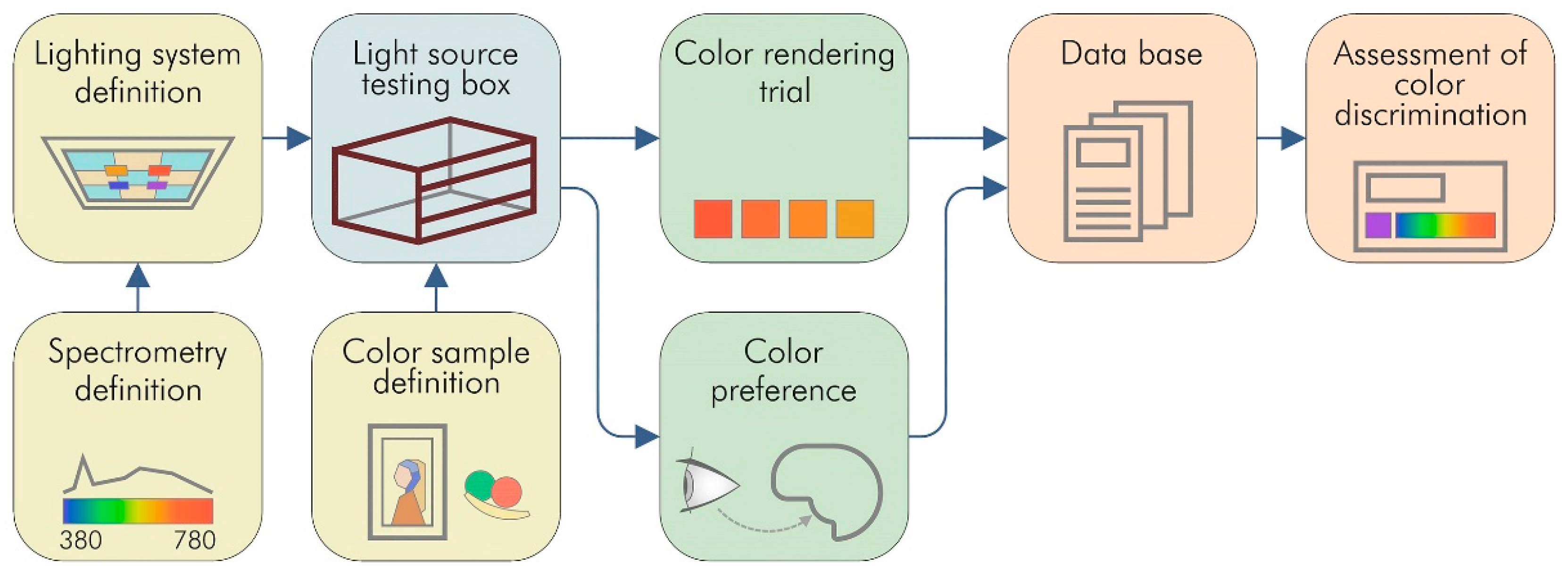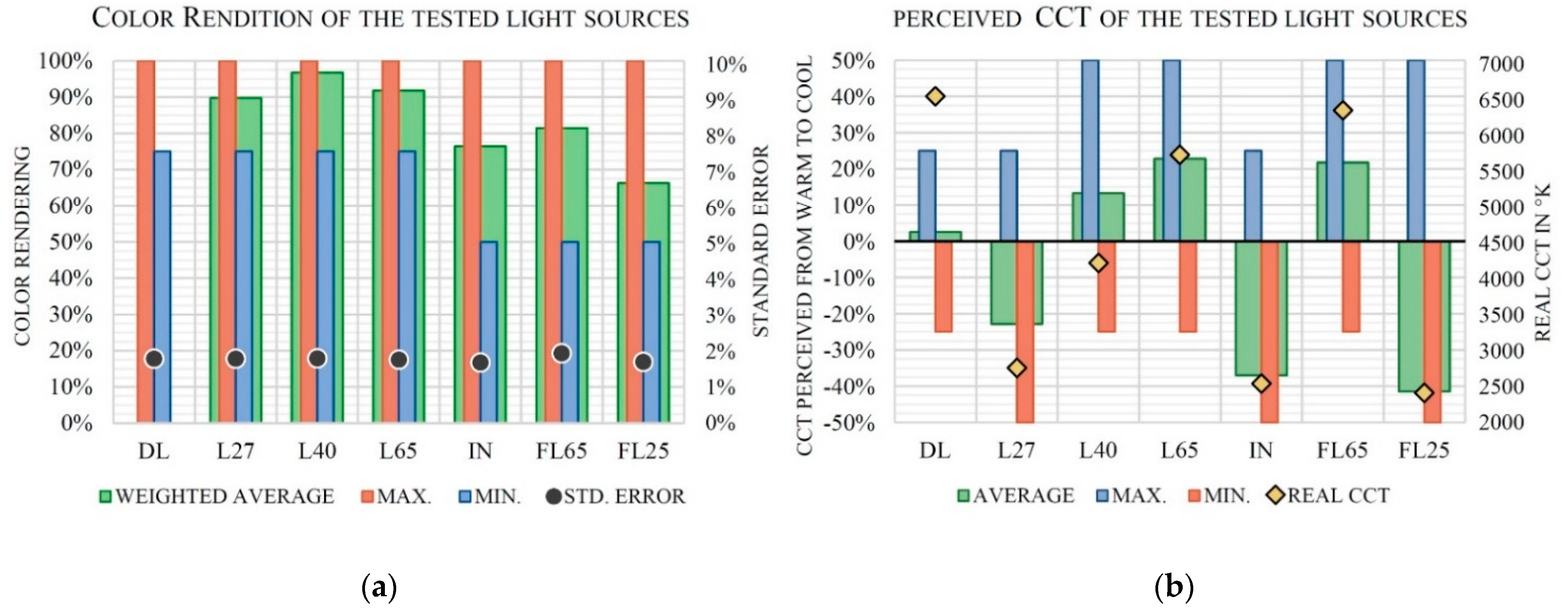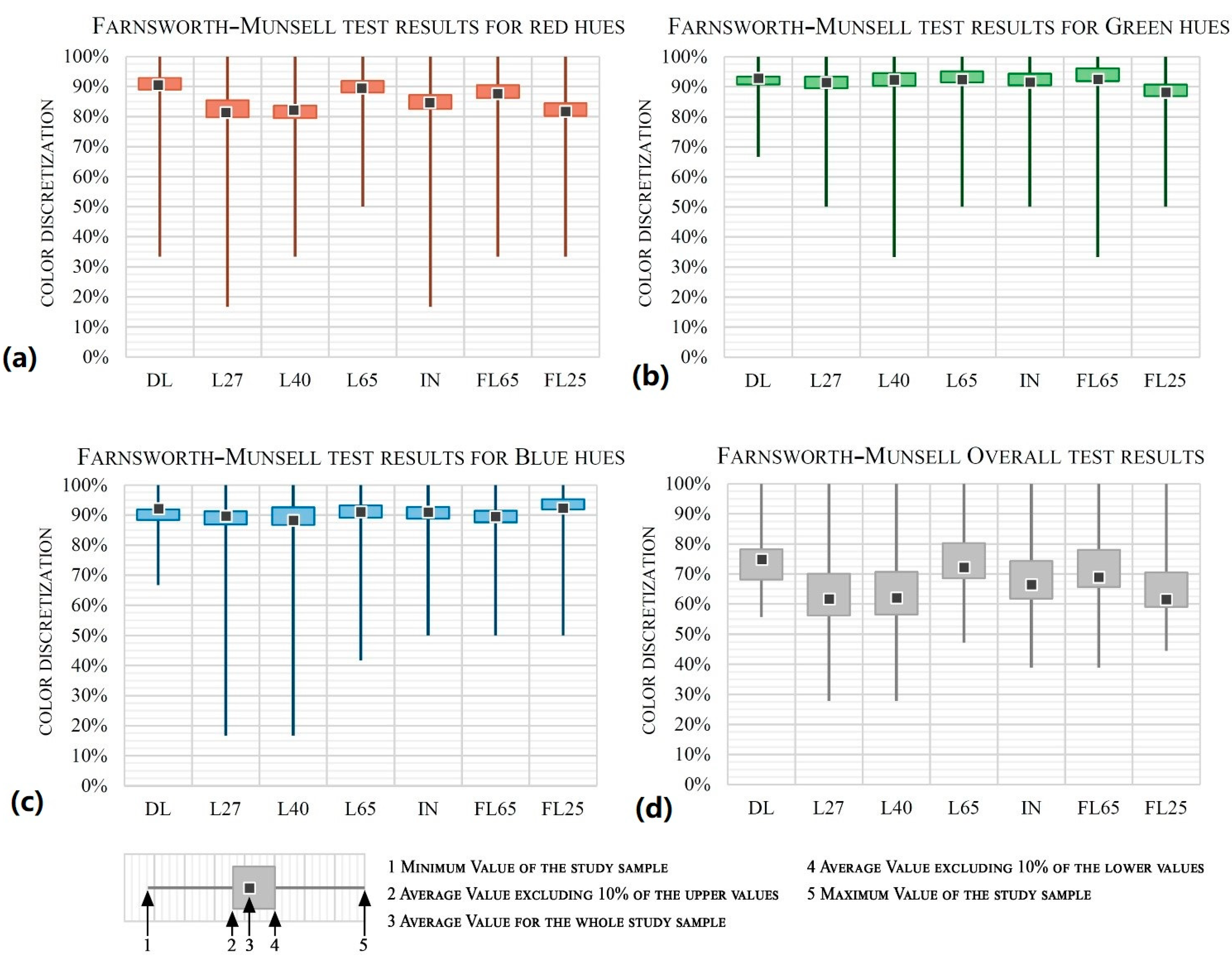Assessment of Color Discrimination of Different Light Sources
Abstract
:1. Introduction and Objectives
1.1. Background
1.2. Aim and Objectives
- Two recently proposed metrics are evaluated, TM-30-20 and DSI. The precision of these metrics had not previously been evaluated for color discrimination.
- Finally, this research provides a relationship between the scores given by most of the current color rendering metrics and the ability to discretize the hues, considering other characteristics of the light source, such as CCT and SPD.
2. Methodology
2.1. Light Source Testing Box
2.2. Light Sources Analyzed
2.3. Color Samples
2.4. Quantification of the Results
3. Analysis of Results
3.1. Color Rendering of the Light Sources
3.2. Color Saturation and Preference of the Light Sources
3.3. Color Discrimination Provided by the Light Sources
3.4. Adequacy of the Main Metrics with Color Discrimination
4. Discussion
5. Conclusions
Author Contributions
Funding
Institutional Review Board Statement
Informed Consent Statement
Data Availability Statement
Acknowledgments
Conflicts of Interest
References
- Acosta, I.; Campano, M.; Domínguez-Amarillo, S.; Muñoz, C. Dynamic Daylight Metrics for Electricity Savings in Offices: Window Size and Climate Smart Lighting Management. Energies 2018, 11, 3143. [Google Scholar] [CrossRef] [Green Version]
- Lin, Y.; Wei, M.; Smet, K.; Tsukitani, A.; Bodrogi, P.; Khanh, T. Colour preference varies with lighting application. Light. Res. Technol. 2015, 49, 316–328. [Google Scholar] [CrossRef]
- Acosta, I.; Campano, M.; Domínguez, S.; Fernández-Agüera, J. Minimum Daylight Autonomy: A New Concept to Link Daylight Dynamic Metrics with Daylight Factors. LEUKOS J. Illum. Eng. Soc. N. Am. 2019, 15, 251–269. [Google Scholar] [CrossRef]
- Bellia, L.; Acosta, I.; Campano, M.; Fragliasso, F. Impact of daylight saving time on lighting energy consumption and on the biological clock for occupants in office buildings. Sol. Energy 2020, 211, 1347–1364. [Google Scholar] [CrossRef]
- Acosta, I.; Leslie, R.; Figueiro, M. Analysis of circadian stimulus allowed by daylighting in hospital rooms. Light. Res. Technol. 2016, 49, 49–61. [Google Scholar] [CrossRef]
- Bellia, L.; Spada, G.; Pedace, A.; Fragliasso, F. Methods to Evaluate Lighting Quality in Educational Environments. Energy Procedia 2015, 78, 3138–3143. [Google Scholar] [CrossRef] [Green Version]
- Natanian, J.; Aleksandrowicz, O.; Auer, T. A parametric approach to optimizing urban form, energy balance and environmental quality: The case of Mediterranean districts. Appl. Energy 2019, 254, 113637. [Google Scholar] [CrossRef]
- Acosta, I.; Campano, M.; Leslie, R.; Radetsky, L. Daylighting design for healthy environments: Analysis of educational spaces for optimal circadian stimulus. Sol. Energy 2019, 193, 584–596. [Google Scholar] [CrossRef]
- Bullough, J. LEDs and automotive lighting applications. In Nitride Semiconductor Light-Emitting Diodes (LEDs). Materials, Technologies, and Applications, 2nd ed.; Elsevier: Amsterdam, The Netherlands, 2018; pp. 647–658. [Google Scholar]
- Bullough, J.; Snyder, J.; Kiefer, K. Impacts of average illuminance, spectral distribution, and uniformity on brightness and safety perceptions under parking lot lighting. Light. Res. Technol. 2019, 52, 626–640. [Google Scholar] [CrossRef]
- David, A.; Sahlhoff, D.; Wisser, M. Human perception of light chromaticity: Short-wavelength effects in spectra with low circadian stimulation, and broader implications for general LED sources. Opt. Express 2019, 27, 31553–31566. [Google Scholar] [CrossRef] [PubMed]
- Sándor, N.; Schanda, J. Visual colour rendering based on colour difference evaluations. Light. Res. Technol. 2006, 38, 225–239. [Google Scholar] [CrossRef]
- CIE. CIE: Publication CIE 13.2 (TC-3.2); Commission Internationale de l’Éclairage: Vienna, Austria, 1974. [Google Scholar]
- CIE. CIE S 017:2011—International Lighting Vocabulary; Commission Internationale de l’Éclairage: Vienna, Austria, 2011. [Google Scholar]
- Macadam, D.L. Visual Sensitivities to Color Differences in Daylight. J. Opt. Soc. Am. 1942, 32, 247–274. [Google Scholar] [CrossRef]
- Schanda, J. A combined colour preference—Colour rendering index. Light. Res. Technol. 1985, 17, 31–34. [Google Scholar] [CrossRef]
- Royer, M.P. What Is the Reference? An Examination of Alternatives to the Reference Sources Used in IES TM-30-15. LEUKOS 2016, 13, 71–89. [Google Scholar] [CrossRef]
- CIE. Colour Rendering (TC1-33 Closing Remarks); Commission Internationale de l’Éclairage: Vienna, Austria, 1999. [Google Scholar]
- Davis, W.; Ohno, Y. Color quality scale. Opt. Eng. 2010, 49, 033602. [Google Scholar] [CrossRef] [Green Version]
- Jost-Boissard, S.; Avouac, P.; Fontoynont, M. Assessing the colour quality of LED sources: Naturalness, attractiveness, colourfulness and colour difference. Light. Res. Technol. 2014, 47, 769–794. [Google Scholar] [CrossRef]
- Smet, K.; Schanda, J.; Whitehead, L.; Luo, R. CRI2012: A proposal for updating the CIE colour rendering index. Light. Res. Technol. 2013, 45, 689–709. [Google Scholar] [CrossRef]
- Li, C.; Ronnier Luo, M.; Li, C.; Cui, G. The CRI-CAM02UCS colour rendering index. Color Res. Appl. 2012, 37, 160–167. [Google Scholar] [CrossRef]
- Illuminating Engineering Society. IES Method for Evaluating Light Source Color Rendition, IES Technical Memorandum (TM) 30-20, IESNA; IES: New York, NY, USA, 2020; Available online: https://store.ies.org/product/tm-30-20-ies-method-for-evaluating-light-source-color-rendition/ (accessed on 17 July 2021).
- Royer, M.P. IES TM-30-15 Is Approved—Now What? LEUKOS 2016, 12, 3–5. [Google Scholar] [CrossRef] [Green Version]
- Illuminating Engineering Society. IES Method for Evaluating Light Source Color Rendition, IES Technical Memorandum (TM) 30-15, IESNA; IES: New York, NY, USA, 2015; Available online: https://www.ies.org/about-outreach/position-statements/ps-11-18-ies-position-on-tm-30-18-ies-method-for-evaluating-light-source-color-rendition/ (accessed on 21 January 2020).
- CIE. CIE 2017 Colour Fidelity Index for Accurate Scientific Use; Commission Internationale de l’Éclairage: Vienna, Austria, 2017. [Google Scholar]
- Acosta, I.; León, J.; Bustamante, P. Daylight spectrum index: A new metric to assess the affinity of light sources with day-lighting. Energies 2018, 11, 2545. [Google Scholar] [CrossRef] [Green Version]
- Thornton, W.A. Color-Discrimination Index. J. Opt. Soc. Am. 1972, 62, 191–194. [Google Scholar] [CrossRef] [PubMed]
- Boyce, P. Illuminance, lamp type and performance on a colour discrimination task. Light. Res. Technol. 1976, 8, 195–199. [Google Scholar] [CrossRef]
- Boyce, P.; Simons, R. Hue discrimination and light sources. Light. Res. Technol. 1977, 9, 125–140. [Google Scholar] [CrossRef]
- Rea, M.S.; Freyssinier-Nova, J.P. Color rendering: A tale of two metrics. Color Res. Appl. 2008, 33, 192–202. [Google Scholar] [CrossRef]
- Farnsworth, D. The Farnsworth-Munsell 100-Hue and Dichotomous Tests for Color Vision. J. Opt. Soc. Am. 1943, 33, 568–574. [Google Scholar] [CrossRef]
- Rea, M.; Freyssinier, J. Color rendering: Beyond pride and prejudice. Color Res. Appl. 2010, 35, 401–409. [Google Scholar] [CrossRef]
- Royer, M.P.; Houser, K.W.; Wilkerson, A.M. Color discrimination capability under highly structured spectra. Color Res. Appl. 2011, 37, 441–449. [Google Scholar] [CrossRef]
- Royer, M.P.; Wei, M. The Role of Presented Objects in Deriving Color Preference Criteria from Psychophysical Studies. LEUKOS 2017, 13, 143–157. [Google Scholar] [CrossRef]
- Schanda, J.; Csuti, P.; Szabó, F. Colour fidelity for picture gallery illumination, Part 1: Determining the optimum light-emitting diode spectrum. Light. Res. Technol. 2014, 47, 513–521. [Google Scholar] [CrossRef] [Green Version]
- Feltrin, F.; Leccese, F.; Hanselaer, P.; Smet, K.A.G. Impact of Illumination Correlated Color Temperature, Background Lightness, and Painting Color Content on Color Appearance and Appreciation of Paintings. LEUKOS 2019, 16, 25–44. [Google Scholar] [CrossRef]
- Szabó, F.; Kéri, R.; Schanda, J.; Csuti, P.; Wilm, A.; Baur, E. A study of preferred colour rendering of light sources: Shop lighting. Light. Res. Technol. 2015, 48, 286–306. [Google Scholar] [CrossRef]
- Royer, M.; Wei, M.; Wilkerson, A.; Safranek, S. Experimental validation of colour rendition specification criteria based on ANSI/IES TM-30-18. Light. Res. Technol. 2019, 52, 323–349. [Google Scholar] [CrossRef]
- Houser, K.W.; Wei, M.; David, A.; Krames, M. Whiteness Perception under LED Illumination. LEUKOS 2014, 10, 165–180. [Google Scholar] [CrossRef]
- Dangol, R.; Bhusal, P.; Halonen, L. Performance of colour fidelity metrics. Light. Res. Technol. 2014, 47, 897–908. [Google Scholar] [CrossRef] [Green Version]
- Gu, H.; Luo, M.R.; Liu, X. Testing different colour rendering metrics using colour difference data. Light. Res. Technol. 2016, 49, 539–560. [Google Scholar] [CrossRef]
- Esposito, T. An Adjusted Error Score Calculation for the Farnsworth-Munsell 100 Hue Test. LEUKOS 2019, 15, 195–202. [Google Scholar] [CrossRef] [Green Version]
- Esposito, T.; Houser, K. A new measure of colour discrimination for LEDs and other light sources. Light. Res. Technol. 2017, 51, 5–23. [Google Scholar] [CrossRef]
- De Beer, E.; Van Der Burgt, P.; Van Kemenade, J. Another Color Rendering Metric: Do We Really Need It, Can We Live without It? LEUKOS 2016, 12, 51–59. [Google Scholar] [CrossRef]
- O’Connor, D.A.; Davis, R.G. Lighting for the elderly: The effects of light source spectrum and illuminance on color discrimination and preference. LEUKOS J. Illum. Eng. Soc. North Am. 2005, 2, 123–132. [Google Scholar] [CrossRef]
- Dangol, R.; Islam, M.; LiSc, M.H.; Bhusal, P.; Puolakka, M.; Halonen, L. Subjective preferences and colour quality metrics of LED light sources. Light. Res. Technol. 2013, 45, 666–688. [Google Scholar] [CrossRef]
- Panda-Jonas, S.; Jonas, J.B.; Jakobczyk-Zmija, M. Retinal Photoreceptor Density Decreases with Age. Ophthalmology 1995, 102, 1853–1859. [Google Scholar] [CrossRef]
- Ishihara, S. Tests for Color-Blindness; Hongo Harukicho: Tokyo, Japan, 1917. [Google Scholar]
- Birch, J. Efficiency of the Ishihara test for identifying red-green colour deficiency. Ophthalmic Physiol. Opt. 1997, 17, 403–408. [Google Scholar] [CrossRef] [PubMed]
- Chen, W.; Huang, Z.; Liu, Q.; Pointer, M.R.; Liu, Y.; Gong, H. Evaluating the color preference of lighting: The light booth matters. Opt. Express 2020, 28, 14874–14883. [Google Scholar] [CrossRef] [PubMed]
- ISO. ISO 7730:2005—Ergonomics of the Thermal Environment—Analytical Determination and Interpretation of Thermal Comfort Using Calculation of the PMV and PPD Indices and Local Thermal Comfort Criteria; International Organization for Standardization: Geneva, Switzerland, 2005. [Google Scholar]
- Huang, Z.; Chen, W.; Liu, Q.; Wang, Y.; Pointer, M.R.; Liu, Y.; Liang, J. Towards an optimum colour preference metric for white light sources: A comprehensive investigation based on empirical data. Opt. Express 2021, 29, 6302–6319. [Google Scholar] [CrossRef]









| Instrument | Spectral Wavelength Range | Output Wavelength Pitch | Accuracy |
|---|---|---|---|
| Konica Minolta CL-70F spectrometer | 380 to 780 nm | 1 nm | Ev (Illuminance): ±5% ± 1% per digit xy: 0.003 (at 800 lx) |
| PCE-CSM 8 reflectance spectrophotometer | 400 to 700 nm | 10 nm | ΔE*ab (CIELAB distance metric) 0.2 |
| Abbreviation | DL | L27 | L40 | L65 | IN | FL65 | FL25 |
|---|---|---|---|---|---|---|---|
| Description | Daylight CIE D65 | LED 2700K | LED 4000K | LED 6500K | Incandescent | Fluorescent 6500K | Fluorescent 2500K |
| CCT K | 5500–6500 | 2754 | 4199 | 5692 | 2538 | 6307 | 2406 |
| CRI Ra | 100 | 83 | 84 | 83 | 99 | 87 | 84 |
| GAI D65 | 100 | 47 | 72 | 83 | 42 | 105 | 49 |
| GAI CRI | 100 | 91 | 86 | 87 | 97 | 106 | 112 |
| CQS | 100 | 84 | 84 | 81 | 99 | 86 | 78 |
| CIE 224 2017 | 100 | 85 | 84 | 83 | 99 | 86 | 72 |
| TM-30-20 Rf | 100 | 85 | 84 | 83 | 99 | 86 | 72 |
| TM-30-20 Rg | 100 | 96 | 92 | 92 | 99 | 103 | 106 |
| DSI | 100 | 80 | 85 | 87 | 83 | 73 | 57 |
| Abbreviation | DL | L27 | L40 | L65 | IN | FL65 | FL25 | Farnworth–Munsell R2 | Subjective Color Rendition R2 | Color Saturation Deviation R2 | Fruit Set Preference R2 | Paintings Set Preference R2 |
| CCT K | 5500–6500 | 2754 | 4199 | 5692 | 2538 | 6307 | 2406 | |||||
| CRI Ra | 100 | 83 | 84 | 83 | 99 | 87 | 84 | 0.273 | 0.010 | 0.004 | 0.126 | 0.010 |
| GAI D65 | 100 | 47 | 72 | 83 | 42 | 105 | 49 | 0.536 | 0.260 | 0.485 | 0.164 | 0.336 |
| GAI CRI | 100 | 91 | 86 | 87 | 97 | 106 | 112 | 0.001 | 0.495 | 0.005 | 0.274 | 0.314 |
| CQS | 100 | 84 | 84 | 81 | 99 | 86 | 78 | 0.259 | 0.076 | 0.000 | 0.279 | 0.087 |
| CIE 224 2017 | 100 | 85 | 84 | 83 | 99 | 86 | 72 | 0.326 | 0.190 | 0.004 | 0.417 | 0.196 |
| TM-30-20 Rf | 100 | 85 | 84 | 83 | 99 | 86 | 72 | 0.326 | 0.190 | 0.004 | 0.417 | 0.196 |
| TM-30-20 Rg | 100 | 96 | 92 | 92 | 99 | 103 | 106 | 0.003 | 0.496 | 0.010 | 0.233 | 0.299 |
| DSI | 100 | 80 | 85 | 87 | 83 | 73 | 57 | 0.427 | 0.758 | 0.200 | 0.790 | 0.597 |
Publisher’s Note: MDPI stays neutral with regard to jurisdictional claims in published maps and institutional affiliations. |
© 2021 by the authors. Licensee MDPI, Basel, Switzerland. This article is an open access article distributed under the terms and conditions of the Creative Commons Attribution (CC BY) license (https://creativecommons.org/licenses/by/4.0/).
Share and Cite
Bustamante, P.; Acosta, I.; León, J.; Campano, M.A. Assessment of Color Discrimination of Different Light Sources. Buildings 2021, 11, 527. https://doi.org/10.3390/buildings11110527
Bustamante P, Acosta I, León J, Campano MA. Assessment of Color Discrimination of Different Light Sources. Buildings. 2021; 11(11):527. https://doi.org/10.3390/buildings11110527
Chicago/Turabian StyleBustamante, Pedro, Ignacio Acosta, Jesús León, and Miguel Angel Campano. 2021. "Assessment of Color Discrimination of Different Light Sources" Buildings 11, no. 11: 527. https://doi.org/10.3390/buildings11110527
APA StyleBustamante, P., Acosta, I., León, J., & Campano, M. A. (2021). Assessment of Color Discrimination of Different Light Sources. Buildings, 11(11), 527. https://doi.org/10.3390/buildings11110527







